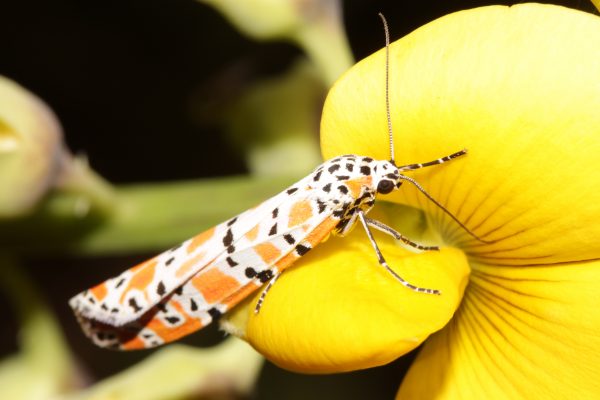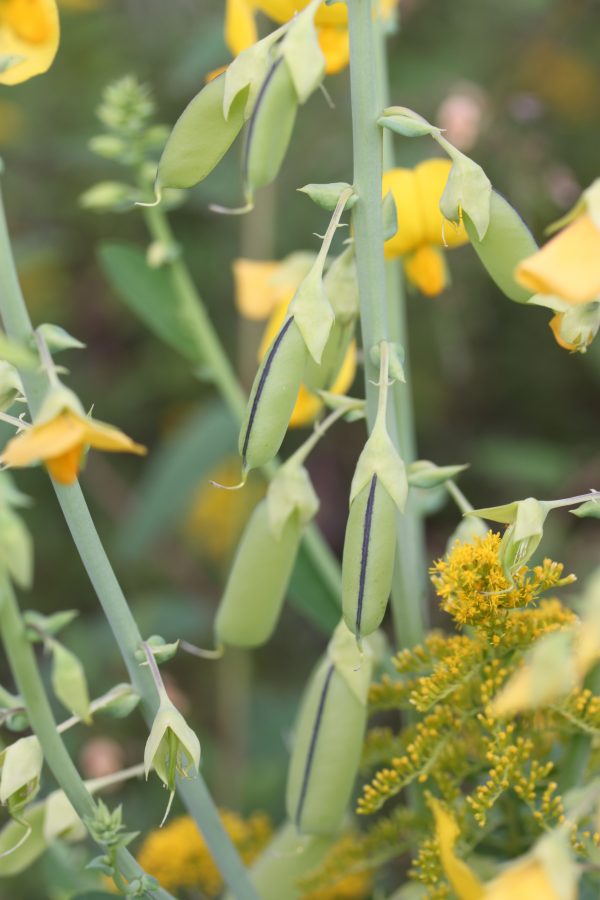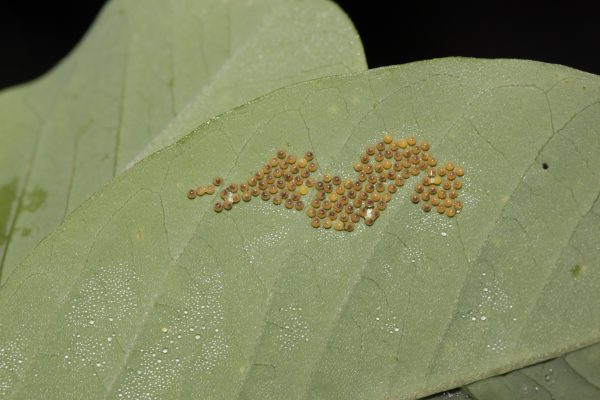
Florida Museum photo by Andrei Sourakov
Taming a wild plant may not sound too ominous, unless you are a tiny moth and the plant is 8 feet tall and poisonous.
Lepidopterist Andrei Sourakov with the Florida Museum of Natural History has been studying ornate bella moths, Utetheisa ornatrix, since 2010. His March 2015 study appearing in the Journal of Natural History reveals that the moth is changing its ecology, co-evolving as it adjusts to feeding on the seeds of several invasive exotic plant species.
“Once a species is introduced, they may take on a life of their own,” said Sourakov, collections coordinator at the museum’s McGuire Center for Lepidoptera and Biodiversity on the University of Florida campus. “Eradicating a foreign species that has established is very difficult if not impossible.”
With his trademark spectacles and safari hat, David Fairchild, known as the Indiana Jones of botany, traveled the world during the early 1900s in search of plants and collected thousands of exotics and new varieties, like pistachios, mangos, dates, cotton and wheat, and introduced them to the United States. Fairchild’s writings suggest a variety of exotic rattlebox plants in the genus Crotalaria were introduced to South Florida about 100 years ago. Among them is Crotalaria spectabilis, showy rattlebox, which particularly stands out with its 6- to 8 feet-tall plants and beautiful yellow flowers. It was praised by Fairchild and others as being an effective cover crop, which not only is able to enrich soil with nitrogen, but also is able to trap nematodes.
According to Fairchild, this particular plant was introduced from India around 1914. Today, some Crotalaria plants are still used as cover crops in the United States (mostly in the South), and around the world. For example Sun Hemp, Crotalaria juncea, which has been used in India as a crop since 600 B.C., is recommended by UF’s Institute of Food and Agricultural Sciences as “a summer cover crop for Florida growers because it returns nitrogen to the soil, suppresses weeds and nematodes, improves soil tilth and water-holding capacity, and reduces erosion in fields otherwise left without plant cover.”
It is not clear if people who introduced rattlebox plants were aware they are poisonous to livestock and can become nuisance invasive exotics, sometimes completely overrunning the ecosystem. Today, the plant would control many Florida habitats if it weren’t for the tiny pinkish-red ornate bella moth keeping it at bay.

Florida Museum photo by Andrei Sourakov
“Horse and cattle folks know that these plants are poisonous to their livestock,” Sourakov said. “They affect their livers and their alkaloids even have been found to have DNA damaging effects.”
Sourakov said species of rattlebox have also been occasionally documented to grow among crops, ultimately contaminating cereal consumed by humans, and herbs used in tea. Though such occurrences are rare, the health concerns prompted testing of some products for Pyrrolizidine alkaloids – the harmful components of Crotalaria.
Today in Florida, these exotic species often grow on abandoned farmland that has transformed into forest. Sourakov stumbled upon one of Florida’s 10 exotic species of rattlebox (there are four native species) in 2011 growing near the edge of a wooded area in northwest Gainesville. A year later, he noticed the seasonal plant had dwindled more than 90 percent. He discovered the culprit was the bella moth, which he observed eating seeds from pods that grow on the plant. The pods resemble pea pods and rattle when the plant stem is moved. The seeds contain alkaloids that are poisonous to some insects and other animals. But the bella moth relies on these particular alkaloids to produce chemical defenses and pheromones.
“The moth has always fed on native species of Crotalaria,” said Sourakov, showing a drawer with hundreds of bella moth specimens that he reared in the lab. “They can’t tell the difference between the native and the invasive species. However, the native and exotic species have very different habitat preferences, and seasonal patterns of growth.”
Sourakov’s research follows in the footsteps of the late Thomas Eisner, a Cornell University scientist who became known as the father of chemical ecology. His pioneering lab experiments involving bella moths revealed how insects use chemicals to attract mates as well as prey, and elude predators. It was Eisner who noticed the alkaloids that allow the bella moths to flourish are poisonous to some other bugs, including spiders. During his experiments, spiders that caught bella moths in their webs and got a taste of the unpleasant alkaloids opted to cut the moths free, rather than finish the meal.
Eisner’s lab experiments showed female bella moths are attracted to the same toxins in potential mates. The male even shares some of the toxic chemical with the female during mating, which in turn makes her eggs taste disgusting to other insects.

Florida Museum of Natural History photo by Andrei Sourakov
Sourakov has taken research of Eisner and his colleagues forward, out of the lab and into the real world. He’s observed the introduction of several rattlebox species, all with different morphology, ecology and chemistry, has resulted in a substantial expansion of the bella moth’s habitat and activity patterns. He found the moth feeding on rattlebox in several different habitats in Gainesville throughout most of the year. In the upland pine habitat behind the Florida Museum, Sourakov witnessed bella moths feeding on the exotic species C. lanceolata at the beginning of October two years in a row. But by late November each year, the plant had nearly disappeared. But a nearby patch of native C. pumila became the new site of larval development for the moth.
Sourakov continued searching for bella moths feeding on Crotalaria in the Gainesville area. He found C. spectabilis growing in Micanopy Hammock in 2013 had its seeds depleted by the bella moths from July through October. By late November, the plant was nearly dead. The lightly consumed C. retusa nearby became the new host plant, allowing the moth to continue to persist through December. Meanwhile, in Cross Creek, the moths start flying as early as March, laying eggs on the early sprouts of the native C. rotundifolia.
In his lab experiments with these plant species, which Sourakov propagated from seeds with the help of volunteers, the moth’s biology was shown to vary depending on the species of rattlebox plant used as food.
Sourakov, with the help of UF undergraduate students, is now continuing to explore the ongoing coevolution of plants and moths.
“In this day and age, some of these rattlebox plants probably wouldn’t have been introduced because people are more aware of the negative impacts of introducing exotic species and how they can became a nuisance,” he said. “But in this case, we have a rare success story. A native species of moth does a good job of keeping these plants under control, and provides a great research model for me and my students.”
Learn more about the McGuire Center for Lepidoptera & Biodiversity at the Florida Museum.